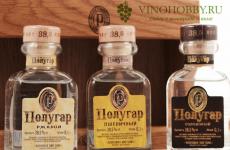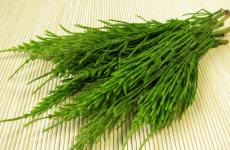The best way to treat the floor in a bathhouse from rot and fungus - modern means and ancient methods. We protect floors from deformation and destruction How to treat the floor in a sauna
When building baths, wood is most often used - it is an environmentally friendly material with good thermal insulation characteristics. But when high humidity the tree begins to actively rot, mold and mildew grow on it. In order for the wooden flooring to last as long as possible, it is important for the owner to know what to treat it with and what impregnations are best suited for this.
Why does rot appear?
Wet wood is an excellent environment for fungi to multiply and spread their spores. The process of decay is significantly accelerated when air stagnates, but in bathhouses they often make thermal insulation, which complicates air exchange and reduces the gas permeability coefficient of wood. If you lay a wood floor without any treatment, it will rot in literally 6–10 months.
If you have cracks in your wood, we recommend that you read the article
When the floor rots in the bathhouse, there will be a constant smell of dampness.
How to treat the floor in a bathhouse from rotting
- Treatment with antiseptic primer. Solutions in the form of a ready-made antiseptic or concentrate are sold in construction stores. It should be applied in 2-3 layers.
- Impregnation using drying oil or linseed oil. The wood is completely immersed in a container with oil and kept for several hours. Impregnation will help “close” the pores in the wood and prevent moisture from getting inside.
Before applying the antiseptic, the wood is dried under ultraviolet light.
Step-by-step instruction
Go carefully over all the boards with a hammer - wood affected by rot will give off a dull sound.
Floor treatment is carried out according to the following instructions:
- Boards or beams are cleaned using an electric planer, also removing the top rotten layer (if any).
- The wood is dried in the sun or simply outdoors(it is also possible with sub-zero temperature on the street).
- Treat with wood antiseptic in 2-3 layers.
- Impregnate with drying oil or linseed oil, after which the wood must be rubbed with a dry cloth to remove excess impregnation.
If there are completely damaged areas of the floor in the bathhouse, they should be replaced with fresh boards
If you completely follow the above instructions, then such a floor, even laid on the ground (as is done in summer baths), will last at least 5–10 years. And if you also provide good ventilation indoors, then all 20–30 years.
The peculiarities of using a bathhouse is the high probability of mold and mildew appearing on wooden surfaces. The reason of that - temperature regime and constant humidity. In order to protect the walls and floor of the bathhouse from premature loss of properties, you need to know what is the best way to treat the floor against rot and fungus.
The emergence of microorganisms in the structure of wood is an inevitable phenomenon for a bathhouse. Even with the most careful preparation of materials before installation, over time they will lose their properties. Therefore, it is necessary to periodically carry out preventive actions to prevent mold.
There are several processing methods that reduce the likelihood of destruction of a wooden surface. But before choosing them, all measures should be taken to passively protect materials. To do this, it is necessary to periodically ventilate the room and maintain a normal temperature level. Taken together, this will increase the service life of building materials.
The following methods can be used for protection:
- Conservation. This method involves long-term exposure of wood to toxic substances. It can only be used in factory conditions;
- Antiseptics. Less effective than the one described above. The advantage is the possibility self-application protective composition.
For processing, it is recommended to use ready-made products intended for use in bath conditions. But besides this, it is possible to make protective compounds with your own hands:
- Silicate glue. Before use, it is diluted with water to the required degree of viscosity. Then the resulting liquid is applied to a wooden surface;
- Soda and vinegar. Damaged areas of wood are covered with soda, and then vinegar is sprayed on them. This is a temporary mold removal measure;
- Salt and boric acid. To prepare the solution you will need to dissolve 1 kilogram of salt and 50 grams of salt in 5 liters of water boric acid. Treatment is performed several times with an interval of 1.5-2 hours.
All of these methods are suitable if a small area of wood is infected. If the problem is global, factory means are needed to eliminate it.
Types of protective equipment

Traditionally for protection wooden surfaces paints and varnishes are used. However, such products are not suitable for baths, since they are not intended for these operating conditions. In this case, the floor should be treated using factory-made antiseptics.
The determining condition for choice is the reliability and safety of the impregnation. After application, it should not only prevent the appearance of mold and mildew, but at the same time preserve all the properties of wood. There are several special liquids designed for specific use in the bath:
Neomid 2000
It contains synthetic pyrethroid, cationic substances, and water. Processing is carried out using a brush, roller or spray. A prerequisite is the use of funds personal protection. The average consumption ranges from 100 to 250 g. per 1 m². Cost 200 gr. is about 480 rubles;
Senezh Sauna
After applying the liquid, a moisture-proof and airtight coating is formed on the wooden surface, which prevents the appearance of microorganisms in the structure. To treat 1 m² of surface you will need from 60 to gr. substances. The cost of a container weighing 2.5 kg is 930 rubles;
Ecosept 200
The main ingredients are salts of inorganic and organic acids. It can be used both as a preventive treatment and to remove microorganisms from the wood structure. The average consumption is from 150 to 200 g. per 1 m². The cost of a liter container is 650 rubles.
This is not a complete list protective equipment for treating the floor in the bathhouse. Before choosing a specific composition, you must read the instructions for use in detail and follow all precautions during its application.
An important step in interior decoration baths is a floor treatment. It is necessary to choose the right product and thoroughly saturate the surface. The comfort, hygiene and service life of the materials will depend on the competent and high-quality performance of this work.
Is it worth treating the floors in the bathhouse?
Wooden flooring in the bath complex is in quite extreme conditions. Here the boards are exposed to water, saturated steam, which condenses on the floor, and the temperature rises to 60–70 degrees in a Russian bath and almost 100 degrees in a sauna. Disputes over the advisability of floor treatment in bath rooms arise constantly.
Many people are put off by the possibility of chemical fumes during procedures. On the other hand, mold and the “aroma” of dampness from blackened, decaying floors will ruin any vacation in the bathhouse. Unprotected wood, like a sponge, absorbs microparticles of dirt and soot, which gives a persistent, specific odor. Professionals assure that special impregnation is harmless, and the effect of treated floors contributes to the appearance positive emotions in humans.
One of the popular materials for constructing a floor in a bathhouse is wood. And what comes to the fore here is his negative quality– it undergoes active rotting in a damp room, as it is not able to withstand the penetration of moisture. The destructive process is rotting wood fibers under the influence of fungi and microorganisms that multiply intensively at elevated temperatures and humidity: the floors in the bathhouse begin to turn black and become covered with a white coating. And to prevent this from happening, they use impregnations that protect the wood from rot. Moreover, the presence of a direct source of fire in the premises of a bathhouse or sauna contributes to the ignition of wood, so the floor must be impregnated with compounds that protect the wood from fire.
Concrete floors are also subject to deterioration and require special protection.
Impregnations for concrete floors prevent not only moisture from entering the floor, but also a variety of chemicals. These components can lead to the formation of white streaks or efflorescence (crystallization of salts on the surface of concrete). Impregnations also prevent the penetration of harmful microorganisms that destroy concrete.
Compositions for wood flooring
Bathroom floor impregnation is characterized by high penetrating properties, protecting the boards from moisture, insects and dirt. It reliably clogs the natural pores of the wood, stopping the processes of rotting and decomposition of microorganisms inside the wood. Impregnations can be transparent and colored. In order to get the desired color to highlight the wood texture, just add a drop of dye to the product.
You can treat a wooden floor in a bathhouse with special compounds, which are:
- antiseptic;
- moisture-proof;
- fireproof.
Antiseptic impregnations for acrylic base prevent the vital activity of all types of pathogenic organisms and have:
- resistance to temperature fluctuations, which allows impregnation of the floor in the washing room and steam room;
- resistance to moisture penetration;
- high air permeability, thanks to which the wood can “breathe”.
Protective agents are found in the form of a liquid solution or a dry mixture that requires dissolution with water. Fire-resistant preparations are rarely used in steam rooms. But since they create a non-combustible layer on the surface of the wood, they can be used to treat the floor near the stove.
Bleaching agents are not impregnations, but they can whiten darkened floor boards in bathhouses.
Water-soluble products have the following characteristics: do not contain aggressive chemical components; do not change the structure of the tree; do not allocate unpleasant odors. The main disadvantages include the gradual leaching of the composition from the surface of the wood and the need to re-apply impregnation. Regular ventilation of the premises will extend the life of the protective layer of a wooden floor.
Treating the floor in a bathhouse against rotting with water-soluble impregnations is optimal solution for owners. To thoroughly saturate the wood, it is necessary to apply several layers of a protective composition, combining antibacterial and moisture-protective agents. The treated bath floor will delight you with its durability and beautiful appearance, since many antiseptics contain coloring pigments that highlight the natural beauty of the wood.
Drying oil that penetrates the wood is often used as an impregnation. After drying and thickening it forms protective film. It is used to process the wooden floor of a bathhouse in:
- washing;
- steam room;
- rest room;
- dressing room
There are oil and natural drying oils. Experts say that it is necessary to cover floors in bathhouses where there is a significant increase in temperature with natural compounds that do not contain any synthetic components.
Treating a wooden floor with a folk remedy
You can cover the wood on the floor in the bathhouse with propolis and sunflower oil. To do this, the components are taken in a ratio of 1:3. They should be mixed well and soaked in them on the floor surface, previously cleaned of dust. This method of protecting wood from moisture and rot helps prevent the development of various microorganisms.
To protect the boards from rotting in the bathhouse, you can use another folk method– impregnation with linseed oil. Its main advantages are as follows.
- Environmentally friendly product.
- Penetrates deeply into the wood structure, closing even small pores.
- Has effective water-repellent properties.
- Improves appearance floor wooden surface.
- Protects floors from the effects of fungus and mold, as it has an antiseptic effect.
Flaxseed oil contains glycerides of polyunsaturated acids. Under influence external factors(oxygen, heat, light) the process of their polymerization occurs, that is, they begin to thicken. After complete drying (after 2–3 weeks), a protective film is formed that protects the wooden covering from destruction. To cover 10 sq. m of floor boards will require 1 liter of linseed oil. After treatment, the oil practically does not remain on the wood.
To improve performance properties linseed oil sometimes mixed with wax.
Before covering the floors in the bathhouse with any chosen product, you should clean the wood from grease, dirt and dust, that is, pre-treat the surface. Despite the finishing already carried out, situations may arise when the floors still begin to darken and rot. These parts must be disassembled and dried. Then the surface of the bathhouse floor is finished with sanding paper and the boards are again coated with an antiseptic. After drying, the final step is to finish the damaged area with wax.
Impregnations for concrete floors in bathhouses
Protective agents for concrete are organic and inorganic. The first ones are made on the basis of acrylic, polyurethane and epoxy. Inorganic agents convert soluble components into insoluble ones. The use of such compositions makes it possible to improve the resistance of the coating to the influence of chemical compounds. These impregnations are less popular than the first type.
Types of organic impregnations
It's important to remember that protective compounds enter into chemical reaction with the concrete itself, so before carrying out work, you need to check whether the composition is suitable for your floor. To do this you need to apply the product to small area surface and wait for it to dry. If the concrete does not darken or crumble, and the impregnation covers the floor with a strong, even layer, then you can safely use it.
Are the same drugs suitable for different rooms?
Before choosing an impregnation, you need to decide on the purpose of its use, since each compartment of the bath has a different level of humidity. It is important to remember that the products used for floors should not emit harmful substances or have a strong odor. Due to the fact that there are high temperatures in the sink and steam room, there is a threat of evaporation from the surface of the treated floor, which can be harmful to health.
To prevent the negative effects of impregnation preparations on the body, it is necessary to remember the following.
- In the rest room and locker room, the air temperature usually does not exceed 28 degrees. Therefore, synthetic impregnations can be used in these rooms.
- Prevails in the washroom heat and humidity. The wooden floor there must be impregnated with only organic-based products.
Protective impregnations are presented in quite a variety wide range. Modern means make it possible to combat the destructive process - first of all, rotting. To do right choice, pay attention to the properties of impregnations and correlate them with the characteristics of your bath or sauna - this is the only way you can find perfect option protection specifically for your case.
 If we are talking specifically about the processes of destruction of materials as a result of constant contact with liquids, then first of all we mean wood. It is this that is mainly used both in the construction and interior design baths The question “how to treat the floor in a bathhouse” is more than relevant, but before you understand the preparations and methods of protection against rotting and fungus, you need to clarify something.
If we are talking specifically about the processes of destruction of materials as a result of constant contact with liquids, then first of all we mean wood. It is this that is mainly used both in the construction and interior design baths The question “how to treat the floor in a bathhouse” is more than relevant, but before you understand the preparations and methods of protection against rotting and fungus, you need to clarify something.
Floor (flooring, finishing coat) is a generalized concept. In relation to the bathhouse, they are not subject to treatment in all rooms. Engage in impregnation, painting or other methods of protection wooden products, including floorboards, are not recommended in the steam room. This room is characterized by extreme temperature values and temperature changes, which are quite sharp.
What to consider when treating the floor
- When choosing compositions for treating floors in other rooms of the bathhouse, you should focus on the type of wood and the effect that a particular preparation gives. In this regard, “highly specialized” formulations are preferable. There are many products on sale for impregnation (surface application) of wooden products, which are positioned as universal. But, as you know, there is no cure for all ailments.
- Before purchasing a composition for processing, it would not be superfluous to ask friends, acquaintances, neighbors, etc., what they used and what the effect was. Then it will be possible to make a more objective decision than focusing on various advertisements and opinions of so-called “informed people.”
- You shouldn’t “get hung up” on one thing. The choice of drugs is huge, so it’s worth a try different compositions and draw your own conclusion which one is better.
Tools Overview
Impregnating
 Antiseptics solve several problems in protecting wood. From what misfortunes?
Antiseptics solve several problems in protecting wood. From what misfortunes?
- Fungus.
- Mold.
- Wood-boring insects.
- Appearance of blue.
Recommending something specifically is not the point of the article. It would be more expedient to just list the compounds about which there are most positive reviews on the Internet - “Drevotex” (anti-mold – 890 rubles/10 l), “Texturol” (3,790 rubles/10 l), the often mentioned “Senezh” (Ecobio series) 545 rub/10 kg), “Belinka” (from 690 rub/l), “Pinotex” (2,850 rub/10 l), “Sagus” (925 rub/10 l), “Senezh-Ognebio” (collateral effect, since the main purpose is protection from flames), “Neomid” (from 250 rubles/l), “Schwarz” (1,150 rubles/10 kg), “Natura” (680 rubles/0.9 l).
Surface application
 Products based on wax (natural) and oils (urethane) partially penetrate into the wood structure. By-effect– they give the wood a peculiar “velvety” quality, which attracts buyers. Examples of compositions are “Eurotex”, “Williams”, “Sherwin”, “Osmo”, the already mentioned “Belinka”, “Rogneda”, “Aquatex” (2,350 rubles / 10 l).
Products based on wax (natural) and oils (urethane) partially penetrate into the wood structure. By-effect– they give the wood a peculiar “velvety” quality, which attracts buyers. Examples of compositions are “Eurotex”, “Williams”, “Sherwin”, “Osmo”, the already mentioned “Belinka”, “Rogneda”, “Aquatex” (2,350 rubles / 10 l).
Paint and varnish compositions also provide high-quality protection of wood from rotting. The range of products is huge. If you say “woodwork” in a store, you will be offered many options to suit every taste. However, experts in bath procedures question the advisability of using various paints and varnishes. The main counterargument is that our ancestors never painted the inside. When floorboards, benches, tubs and the like became unusable, they were simply replaced. But paint is a “chemical” and should not be in the bathhouse.
Traditional processing methods
- Problem areas are sprinkled with baking soda and sprayed with vinegar.
- Coating wooden blanks with silicate glue diluted with water.
- Processing wood with mortar copper sulfate(100 g/1 bucket of water).
- A mixture obtained by mixing 5% solutions of potassium dichromate and sulfuric acid.
On a note! Such methods and means are effective for local lesions of the tree, so they can only rid the area of the disease. For comprehensive protection of the material, it is better to use proven industrial preparations.
The best way to extend the maintenance-free life of floorboards in a steam room is to choose the right type of wood. From the point of view of the most optimal combination cost and durability, it is advisable to use larch for flooring in the steam room. Its peculiarity is that when wet, this wood becomes even harder and stronger. The presence of a specific resin in its structure is already a sufficient guarantee reliable protection from rot, mold, fungus and wood-boring beetles. No wonder it is called “resin” and is used to treat many diseases.

If you install a “warm floor” circuit, then artificial heating will contribute to more intensive drying of the flooring boards. As a result, the risk of fungus formation is reduced and the service life of the floor is increased.
You should not skimp on arranging a bathhouse. Wood that has undergone heat treatment, although more expensive, is already sufficiently protected from fungi and rot, that is, less susceptible to their formation.
The bathhouse belongs to the category of premises with a specific microclimate, which creates optimal conditions for the development of pathogenic flora. Mold and mildew love humid environments, so their appearance in damp rooms cannot be called rare. How to treat the floor in the bathhouse? The article will discuss the causes of the problem, as well as effective anti-rot agents that will help cope with it.
Causes of wood rotting

A tree is an organic environment in which pathogenic microorganisms can develop very successfully. Most of them require two components:
- moisture;
- heat.
In a bathhouse, as a rule, wood is used to finish the floors, walls, ceiling, benches and shelves. That is why, without special treatment, logs and floor boards begin to rot. What are the main causes of rot in a room?
- poor waterproofing;
- lack of normal ventilation;
- high temperature and humidity;
- poor quality wood processing.
It is worth noting that certain wood species are more resistant to pathogens than others. For example, coniferous wood contains resins, which contain phytoncides.

We recommend reading Zen channel " zen.yandex.ru/vodakanazer.ru", where you will find a lot of useful information for summer residents and gardeners.
This provides them with “immunity” against mold and mildew. For this reason, in order to prevent floor rotting, it is better to use the following types of wood:
- larch and fir;
- spruce and ash;
- cedar and pine.
The tree species most susceptible to moisture and, accordingly, pathogens are:
- maple and alder;
- aspen and linden;
- birch and elm.
Is it possible to protect wooden materials from rotting? To prevent the appearance of rot in the bathhouse, you can treat the wood with special impregnations and varnishes, which will be discussed further.
Requirements for anti-putrefactive agents

How to cover the floor in a bathhouse? The development of pathogenic flora in a “damp” room can be prevented with the help of special anti-rot compounds. Manufacturers of protective products produce various varnishes and impregnations, but not all of them have the necessary range of properties that would guarantee the absence of rot in the wood.
What properties should a high-quality impregnation have?
- Water repellent. It is water that makes wooden joists and board vulnerable to pathogens. To prevent their development, the wood must be kept dry. To do this, use products that, after application, form a protective non-hygroscopic film on the surface of the floor and wall;
- Antiseptic. The composition of the impregnation in mandatory should include antiseptic components (phytoncides). They prevent the proliferation of fungal spores and mold formation;
- "Repellent." Wood does not always suffer from rotting. Wood-boring insects can also cause damage to the coating. To prevent their occurrence, you can use special formulations that contain insect repellent substances.
Important points

If necessary, you can carry out disinfection in the bathhouse with your own hands. However, many experts do not recommend using synthetic compounds for these purposes. Why? The temperature in the sink and steam room is often very high. It provokes the evaporation of antiseptic components from the surface of the floor or wall that has been treated with it. Some of the volatile components can cause real harm to health.
To prevent negative impact anti-putrefactive agents on the body, the choice of protective compounds must be approached with care:
- In the rest room and dressing room, the air temperature, as a rule, does not exceed 27 degrees. They can be used without problems with synthetic compounds;
- In the sink and steam room both humidity and temperature are high. To eliminate the possibility of volatile substances entering the body, it is better to treat logs, floor boards and other wooden elements organic based compounds.
Types of anti-putrefactive agents

Protect new wood coverings You can prevent spoilage with your own hands if you purchase high-quality compounds. What types of funds can be used for these purposes?
- Lucky. Special varnishes contain antiseptic components that prevent the development of bacteria even in damp wood. They are used as decorative finishing, which at the same time prevents rotting of materials;
- Impregnations. Impregnation is a colorless composition that contains phytoncides. These components protect joists and floor boards from the effects of biological agents - mold, bacteria, etc.;
- Antiseptics. Fungicide-based solutions are toxic. Therefore, they can be applied to walls, floors, joists and other wooden structures only if they are intended to be painted further.
The fewest requirements are for the compositions that will be used in the rest room and dressing room. These are moderate wet areas You can do disinfection yourself using impregnations both plant-based and synthetic-based.
Acrylic-based antiseptics

Acrylic-based antiseptics help prevent the development of almost all types of pathogens. Before application, they are diluted with water, after which they are applied to walls, joists and floor boards. TO distinctive features Such antiseptics include:
- Resistance to temperature fluctuations, which allows surface treatment not only in the rest room, but also in the washing room or steam room;
- Resistance to moisture, which helps prevent wood swelling, which subsequently leads to warping;
- High vapor permeability, thanks to which the wood can “breathe”.
If desired, this impregnation can be applied with your own hands. But before breeding and processing wooden surfaces, it is recommended to use protective glasses and gloves that will protect the skin and eyes from contact with the synthetic product.
Drying oil for processing and floors

Drying oil is a film-forming composition that is made on a plant basis. Drying oil can be used to treat wooden coverings in the following rooms:
- washing;
- steam room;
- rest room;
- dressing room
As a result of polymerization liquid composition forms a very strong protective film that prevents moisture from entering the wood. Drying oil is used to treat coatings not only for disinfection, but also to prevent the appearance of splinters.
There are oil and natural drying oils. According to experts, it is more appropriate to treat walls and floors in rooms where there is a significant increase in temperature natural ingredients, which do not contain any synthetic ingredients.
Mixed impregnations
Where is it better to use mixed impregnations? Mixed products are products that not only protect walls and floors from rotting, but also prevent fire. The washroom is a room with high humidity, so the likelihood of a fire in it is low. In the rest room, air humidity is approximately 60%, and in the dressing room - no more than 30%.
To provide high-quality protection not only from rotting, but also from fire, it is advisable to use mixed types of impregnations in the dressing room. As a rule, such products contain fire retardant reagents that do not pose a threat to health.
Method of using anti-putrefactive agents

To ensure that the floor in the sauna does not rot over time and is not subject to further biological attack, you need to use protective compounds. But to achieve the best effect, you need to know how to apply them correctly. What points should you pay attention to when treating floors with your own hands?
- Before using the product, you should read the instructions provided by the manufacturer on the packaging;
- Before applying impregnation to logs and other wooden coverings, their surface must be dried and, if possible, sanded;
- Regardless of whether the floor covering is processed in a sink or a rest room, it must be applied in several layers;
- Materials are processed at temperatures above 5-7 degrees.
If traces of rotting have already appeared on the surface of the wood, without special chemical treatment premises are indispensable. For these purposes they use antiseptics aggressive action that kills pathogenic flora.






